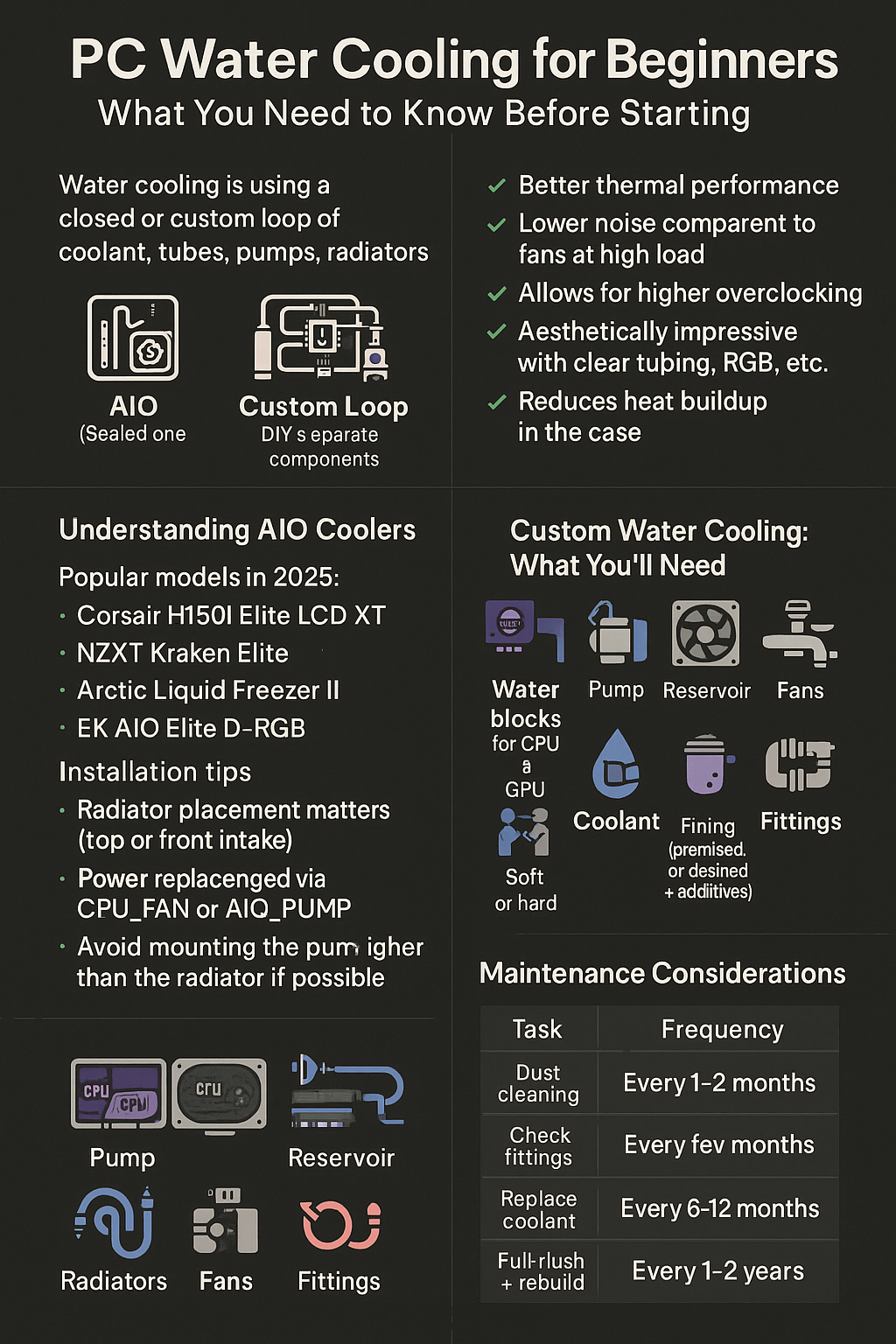Water cooling offers powerful thermal performance and stunning aesthetics, but it can also seem intimidating to beginners. Is it worth switching from air cooling? What are the risks? And how much does it really cost?
This article introduces PC water cooling for beginners, explaining the pros, the parts, and how to start safely — even if you’ve never touched liquid cooling before.
What Is Water Cooling?
Water cooling (also known as liquid cooling) uses a closed or custom loop of coolant, tubes, pumps, and radiators to absorb and dissipate heat from your CPU, GPU, or both.
It comes in two main types:
- AIO (All-In-One): Sealed, pre-assembled units
- Custom Loop: DIY setups with separate components
Why Use Water Cooling?
✅ Better thermal performance
✅ Lower noise compared to fans at high load
✅ Allows for higher overclocking
✅ Aesthetically impressive with clear tubing, RGB, etc.
✅ Reduces heat buildup in the case
Air Cooling vs Water Cooling: Quick Comparison
| Feature | Air Cooling | Water Cooling |
|---|---|---|
| Ease of installation | ✅ Very easy | ❌ More complex |
| Cooling performance | Good | ✅ Excellent under load |
| Noise levels | Moderate | ✅ Quieter with proper tuning |
| Maintenance | Low | ❌ Medium to high (for custom) |
| Aesthetics | Basic | ✅ Stunning |
| Cost | 💲 Affordable | ❌ More expensive |
Understanding AIO Coolers
AIOs are the easiest way to get into water cooling. They’re plug-and-play, with a pump integrated into the CPU block and a sealed radiator/fan combo.
Popular models in 2025:
- Corsair H150i Elite LCD XT
- NZXT Kraken Elite
- Arctic Liquid Freezer II
- EK AIO Elite D-RGB
Installation tips:
- Radiator placement matters: top or front intake
- Make sure pump head is powered via CPU_FAN or AIO_PUMP
- Avoid mounting the pump higher than the radiator if possible
Custom Water Cooling: What You’ll Need
For advanced builders, a custom loop offers extreme performance and aesthetics — but with more effort.
🔹 Components:
- Water blocks for CPU and GPU
- Pump – moves coolant through the loop
- Reservoir – holds coolant and allows bleeding
- Radiators – dissipate heat (120/240/360 mm sizes)
- Fans – pull air through radiators
- Tubing (soft or hard)
- Coolant (premixed or distilled + additives)
- Fittings – connect tubing to hardware
Pros and Cons of Custom Loops
✅ Pros:
- Maximum cooling performance
- Unique, showcase-worthy aesthetics
- Lower noise when optimized
- Can cool multiple components (GPU, CPU, VRMs)
❌ Cons:
- Expensive (typically $400–$1000+)
- Steeper learning curve
- Risk of leaks if poorly built
- Maintenance (flush and refill every 6–12 months)
Is Water Cooling Dangerous?
Modern water cooling is very safe if installed properly.
💡 Tips to stay safe:
- Always leak test before powering on (use jumper plug for PSU)
- Use non-conductive coolant or additives
- Tighten fittings securely, but don’t over-tighten
- Avoid cheap or mismatched tubing/fittings
Beginner-Friendly Water Cooling Tips
- Start with an AIO to get used to pump-powered cooling
- Research loop order and tube routing before custom build
- Use soft tubing first (easier to cut and install)
- Avoid mixing metals (ex: copper and aluminum) to prevent corrosion
- Monitor pump RPM and coolant temperature with software
- Keep a spare bottle of coolant for top-offs or maintenance
Maintenance Considerations
| Task | Frequency |
|---|---|
| Dust cleaning (radiator) | Every 1–2 months |
| Check fittings/leaks | Every few months |
| Replace coolant | Every 6–12 months |
| Full flush + rebuild | Every 1–2 years |
Who Should Use Water Cooling?
✅ Gamers and overclockers seeking max performance
✅ Content creators with long render times
✅ PC modders and enthusiasts
❌ Casual users who want “set and forget” cooling
❌ Budget builders — good air coolers are more cost-effective
Final Thoughts
Water cooling offers high performance, silent operation, and eye-catching aesthetics — but it’s not for everyone. If you’re a beginner, starting with a quality AIO can give you the benefits without the complexity of a full custom loop.
As your confidence grows, you can explore the exciting world of custom water cooling — and truly make your PC a one-of-a-kind build.
